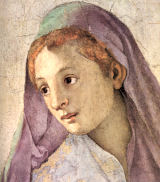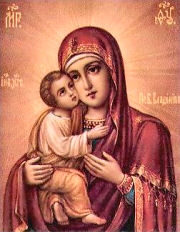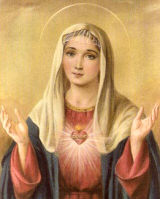 |
| With Mary Immaculate, let us adore, thank, implore and console the Most Beloved and Sacred Heart of Jesus in the Blessed Sacrament. |
Catholic Culture of Month of August.
August, 2015 - Overview for the Month
The month of August is dedicated to The Immaculate Heart of Mary. The entire month falls within the liturgical season of Ordinary Time, which is represented by the liturgical color green. This symbol of hope is the color of the sprouting seed and arouses in the faithful the hope of reaping the eternal harvest of heaven, especially the hope of a glorious resurrection. It is used in the offices and Masses of Ordinary Time. The last portion of the liturgical year represents the time of our pilgrimage to heaven during which we hope for reward.
General: That volunteers may give themselves generously to the service of the needy.
Missionary: That setting aside our very selves we may learn to be neighbors to those who find themselves on the margins of human life and society. (See also Apostleshiop of Prayer International Website)
The feasts on the General Roman Calendar celebrated during the month of August are:
1. Alphonsus Liguori, Memorial 2. Eighteenth Sunday in Ordinary Time, Sunday 4. John Vianney, Memorial 5. Dedication of St. Mary Major, Opt. Mem. 6. Transfiguration, Feast 7. Sixtus II and companions; Cajetan, Opt. Mem. 8. Dominic, Memorial 9. Nineteenth Sunday in Ordinary Time, Sunday 10. Lawrence, Feast 11. Clare, Memorial 13. Pontian and Hippolytus, Opt. Mem. 14. Maximilian Kolbe, Memorial 15. Assumption, Solemnity 16. Twentieth Sunday in Ordinary Time, Sunday 19. John Eudes; St. Bernard Tolomei, Opt. Mem. 20. Bernard, Memorial 21. Pius X, Sunday 22. Queenship of Mary, Memorial 23. Twenty-First Sunday in Ordinary Time, Sunday 24. Bartholomew, Feast 25. Louis of France; Joseph Calasanz, Opt. Mem. 27. Monica, Memorial 28. Augustine, Memorial 29. Passion of Saint John the Baptist , Memorial 30. Twenty-Second Sunday in Ordinary Time, Sunday
The Gospel readings for the Sundays in August 2015 are taken from St. John and St. Mark and are from Year B, Cycle 1.
 August is often considered the transitional month in our seasonal calendar. It is the time of the year we begin to wind-down from our summer travels and vacations and prepare for Autumn — back to school, fall festivals, harvest time, etc. The Church in her holy wisdom has provided a cycle of events in its liturgical year which allow the faithful to celebrate the major feasts in the life of Christ and Mary. Most notably, during August, we celebrate the feast of the Transfiguration (August 6) and the feast of the Assumption (August 15). August is often considered the transitional month in our seasonal calendar. It is the time of the year we begin to wind-down from our summer travels and vacations and prepare for Autumn — back to school, fall festivals, harvest time, etc. The Church in her holy wisdom has provided a cycle of events in its liturgical year which allow the faithful to celebrate the major feasts in the life of Christ and Mary. Most notably, during August, we celebrate the feast of the Transfiguration (August 6) and the feast of the Assumption (August 15).
The other main feasts of this month are St. Alphonsus Ligouri (August 1), St. John Mary Vianney (August 4), Dedication of St. Mary Major (August 5), Transfiguration of the Lord (August 6), St. Sixtus II and Companions and St. Cajetan (August 7), St. Dominic (August 8), St. Lawrence (August 10), St. Clare (August 11), Jane Frances de Chantal (August 12), Sts. Pontian and Hippolytus (August 13), St. Maximilian Kolbe (August 14), St. John Eudes (August 19), St. Bernard(August 20), St. Pius X (August 21), the Queenship of Mary (August 22), St. Bartholomew (August 24), St. Louis of France (August 25), St. Monica (August 27), St. Augustine (August 28) and the Martyrdom of St. John the Baptist (August 29).
The feasts of St. Teresa Benedicta (August 9), St. Stephen of Hungary (August 16) and St. Rose of Lima (August 23) fall on a Sunday so they are superseded by the Sunday Liturgy.
 The days of summer have provided a welcome change of pace. However, while vacations afford us the time to relax and refresh, the change of habits and routines can also have a negative impact on our spiritual lives. As if to re-ignite us, the Church offers us in the plethora of August feasts vivid examples of the virtue of perseverance: six martyrs — two who are named in Canon I of the Mass and two who were martyred during World War II; seven founders of religious congregations, as well as three popes and two kings; the apostle, St. Bartholomew; the great Doctor of the Church, St. Augustine and St. Monica, his mother; the humble patron saint of parish priests, St. John Vianney, and the patron of deacons, St. Lawrence, who joked with his executioners while being roasted alive. The days of summer have provided a welcome change of pace. However, while vacations afford us the time to relax and refresh, the change of habits and routines can also have a negative impact on our spiritual lives. As if to re-ignite us, the Church offers us in the plethora of August feasts vivid examples of the virtue of perseverance: six martyrs — two who are named in Canon I of the Mass and two who were martyred during World War II; seven founders of religious congregations, as well as three popes and two kings; the apostle, St. Bartholomew; the great Doctor of the Church, St. Augustine and St. Monica, his mother; the humble patron saint of parish priests, St. John Vianney, and the patron of deacons, St. Lawrence, who joked with his executioners while being roasted alive.
It is never too late to begin — as the life of the reformed sinner, St. Augustine teaches us — nor too difficult to begin again, as demonstrated by the conversion of the martyr, St. Teresa Benedicta (Edith Stein). We present-day members of the Mystical Body are certain of the reward to which we are called, for Christ’s Transfigured body (August 6) is a preview of that glory. Moreover, in the Assumption of his Mother (August 15), Our Lord has demonstrated his fidelity to his promise. Her privilege is "the highest fruit of the Redemption" and "our consoling assurance of the coming of our final hope — the glorification which is Christ’s" (Enchiridion on Indulgences).
The Blessed Virgin Mary is the most perfect example of Christian perseverance, but she is also our advocate in heaven where she is crowned Queen of Heaven and Earth (August 22). Mary is the "Mother of Perpetual Help", the patroness of the Congregation founded by St. Alphonsus Ligouri (August 1). "No one who has fled to her protection is left unaided" is the claim of the Memorare of St. Bernard (August 20). Heretics have returned to the faith by the prayers of her Rosary, first preached by St. Dominic (August 8) in the twelfth Century, and hearts have been converted by the graces received while wearing her Miraculous Medal, promoted by St. Maximillian Kolbe (August 14) and adopted as the "badge" for the Pious Union he founded. Hail, holy Queen, Mother of Mercy, our life, our sweetness and our hope!
| 
My heart hath rejoiced in God my Savior, because He that is mighty hath done great things for me.
Highlights
 On November 1, 1950, Pope Pius XII defined the dogma of the Assumption. He solemnly proclaimed that the belief whereby the Blessed Virgin Mary, at the end of her life on earth, was taken up body and soul, into the glory of heaven, definitively forms part of the deposit of faith, received from the apostles. On November 1, 1950, Pope Pius XII defined the dogma of the Assumption. He solemnly proclaimed that the belief whereby the Blessed Virgin Mary, at the end of her life on earth, was taken up body and soul, into the glory of heaven, definitively forms part of the deposit of faith, received from the apostles.
The Eastern Church celebrates the Feast of the Transfiguration with ceremonies and processions to the Church where sheaves of wheat, baskets of fruit, and clusters of flowers decorate the altar. When the religious celebration is over, a fair is held, and a pilaf made of cracked wheat is the feature of the feasting. This recipe tastes especially good when eaten out-of doors with barbecued chicken.
Celebrate the feast day of the Assumption with a procession and the Blessing of Herbs and Flowers. Here are numerous ideas for this feast day, including an outdoor procession and tea.
Symbols
Armenia and India are believed to have been the areas of his missionary work. He is said to have been flayed alive and crucified.
A native of North Africa, converted by St. Ambrose and educated at Carthage, the Bishop of Hippo was the writer of his "Confessions" and the "City of God." This symbol refers to his intense zeal and devotion to Christ.
The foundress of the Order of the Poor Clares, whose emblem refers to her dispersion of Saracen invaders by facing them, bearing the Blessed Sacrament, in defense of the convent.
The archdeacon of Rome who, when ordered to deliver the treasures of the Church to pagan authorities, produced the poor and sick of the Christian community as the richest treasures of the Church. He was condemned and burned to death over a gridiron, retaining his cheerful attitude to the end.

With Mary Immaculate, let us adore, thank, implore and console the Most Beloved and Sacred Heart of Jesus in the Blessed Sacrament.
|







No comments:
Post a Comment